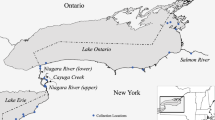Abstract
The elevated mercury (Hg) levels in fish flesh found after impoundment of a reservoir, are predicted to decline as the reservoir ages. The length of time required for a return to background levels is dependent on among other things, the trophic status of the fish. Predictions for omnivorous species range between 15 and 20 years while for piscivorous species they vary from 20 to 30 years. Fish in the Smallwood Reservoir, Labrador, Canada, were sampled 6 years after impoundment when hg levels were found to be elevated in most species. Selected of the sites were re-sampled after 16 years and again after 21 years. Mercury in the flesh of omnivorous species such as lake whitefish (Coregonus clupeaformis) had returned to background levels after 16 years as predicted. However, hg in the flesh of piscivores such as northern pike (Esox lucius) and lake trout (Salvelinus namaycush) remained elevated even 21 years after impoundment. While the levels in lake trout have declined somewhat in that time, there is no evidence of decline in the northern pike either within the reservoir or at downstream stations. Models predicting decline in hg levels in piscivorous fish in reservoirs must be re-evaluated in light of this extended data set.
Similar content being viewed by others
References
Brouard, D., Demers, C., Lalumiere, R., Schetagne, R. and Verdon, R.: 1990. Summary report: Evolution of mercury levels in fish of the La Grande Hydroelectric Complex, Quebec (1978–1989). Hydro Quebec. 97 pages.
Brace, W. J. and Spencer, K. D.: 1979.Can. Indust. Rep. Fish. Aquat. Sci. 111. 12 pages.
Environment Canada: 1979. Analytical Methods Manual, Inland WatersDirectorate. Water Quality Branch, Ottawa, Canada.
Messier, D., Roy, D. and Lemire R.: 1985. Reseau de surveillance ecologique du complexe La Grande 1978–1984. Evolution du mercure dans la chair des poissons. Societe d'energie de la Baie James. 179 pages.
Scruton, D. A.: 1984.Can. Tech. Rep. Fish. Aquat. Sci. 1296. 115 pages.
Scruton, D. A., Petticrew, E. L., LeDrew, L. J., M. R. Anderson, Williams, U. P., Bennett, B. A. and Hill, E. J.: 1994. in Wtras, C. J. and Hackabee, J. W. (Eds.) Mercury Pollution: Integration and Synthesis, Lewis Publishers, Boca Raton, FL. (in press).
Sommers, K. M. and Jackson, D. A.: 1993.Can. J. Fish. Aquat. Sci. 50:2388–2396.
Smith, F. A., Sharma, R. P., Lynn, R. I. and Low J. B.: 1974.Bull. Environ. Contam. Toxicol. 12:153–157.
Uthe, J. F., Armstrong, F. A. J. and Stainton, M. P.: 1970.J. Fish. Res. Board Can. 27:805–817.
Author information
Authors and Affiliations
Rights and permissions
About this article
Cite this article
Anderson, M.R., Scruton, D.A., Williams, U.P. et al. Mercury in fish in the Smallwood Reservoir, Labrador, twenty one years after impoundment. Water Air Soil Pollut 80, 927–930 (1995). https://doi.org/10.1007/BF01189746
Issue Date:
DOI: https://doi.org/10.1007/BF01189746




